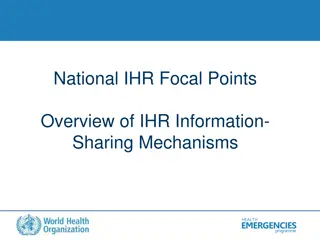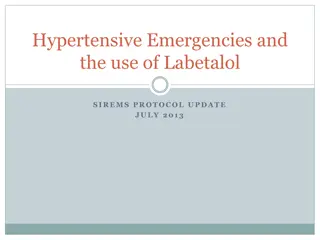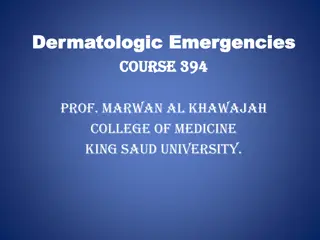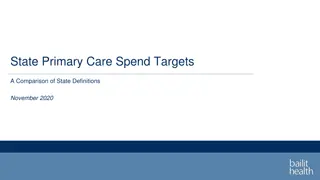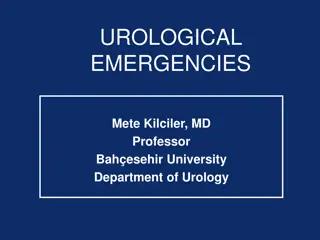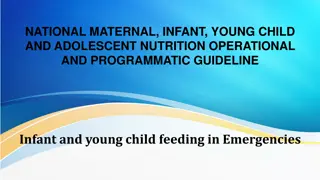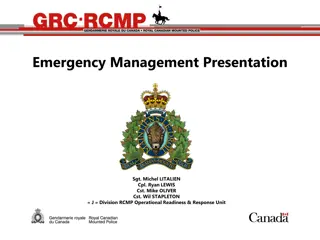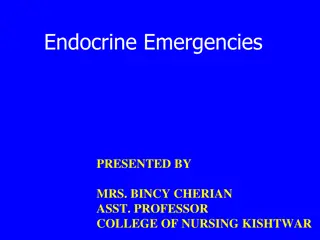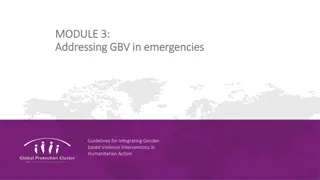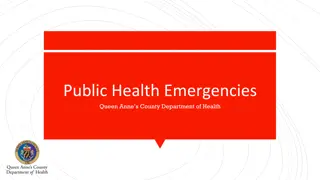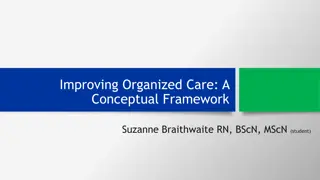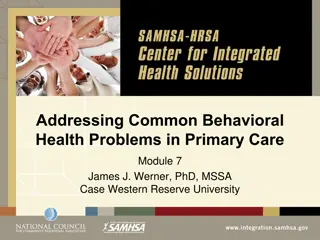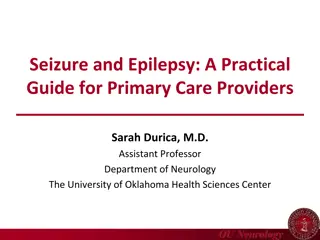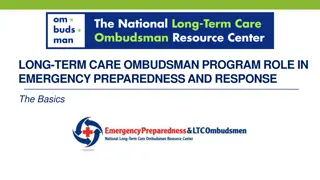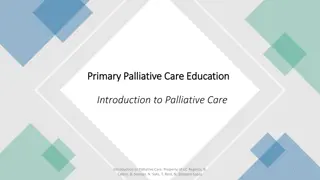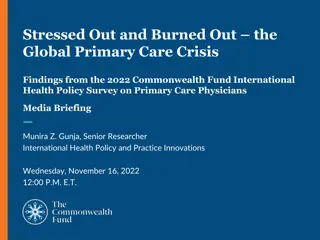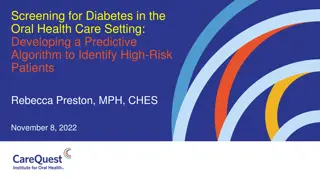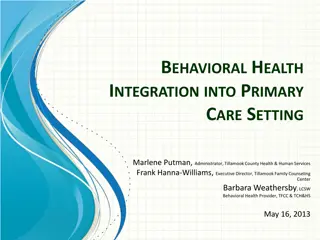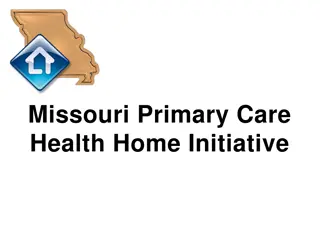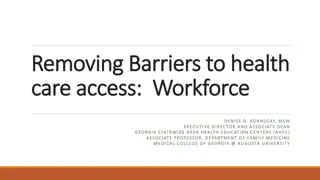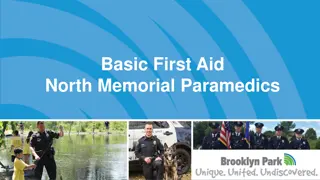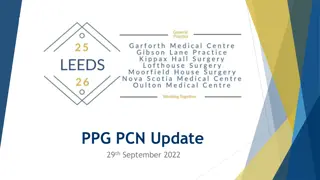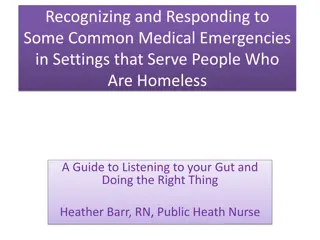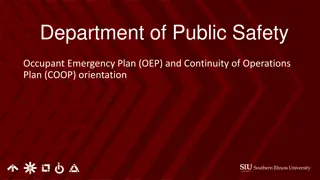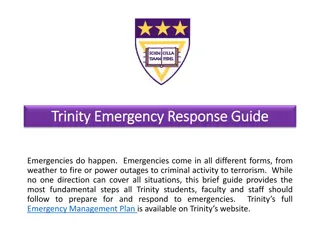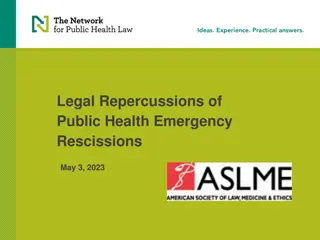Essential Guide to Managing Emergencies in Primary Care
Managing emergencies is crucial for primary care providers. This guide emphasizes the importance of being prepared for any emergency situation that may arise, highlighting the diverse range of emergencies that can be encountered in a primary care setting.
Download Presentation

Please find below an Image/Link to download the presentation.
The content on the website is provided AS IS for your information and personal use only. It may not be sold, licensed, or shared on other websites without obtaining consent from the author. Download presentation by click this link. If you encounter any issues during the download, it is possible that the publisher has removed the file from their server.
E N D
Presentation Transcript
Emergencies in GP By: Dr. JaberBuhamad Specialist Family medicine 10thMay 2018 Instagram& twitter @drjaber85
Introduction Management of emergencies is an integral part in primary care As a first contact care provider you may encounter any type of emergency. Some of the common emergencies : MI, asthma attacks, anaphylactic shock, hypoglycemia, convulsions, head injuries..etc
Content 5 case scenarios Immediate and long term management for each emergency case scenario Interactive questions for each case scenario
Case scenario 35 years old Indian male came to the clinic with his friend in a wheel chair presenting with history of dyspnoea and dizziness. He came to the clinic asking the doctor to check his BP as he thinks that he is having low BP. Patient collapsed within seconds.
Case Scenario Call for help and take the patient to the emergency room Call the ambulance CAB: tachycardia, hypotension, clear airway, tachypnoea, wheezy chest, urticarialrash, swollen lips Collateral history: he had cold and was prescribed antibiotics Diagnosis?
MCQ What is the right epinephrine dose for adults to treat anaphylactic shock? A) 1mg IM - 1ml of 1:1000 epinephrine B) 0.6mg IM- 0.6ml of 1: 1000 epinephrine C) 0.5mg IM- 0.5ml of 1: 1000 epinephrine D) 0.3mg IM- 0.3ml of 1: 1000 epinephrine
Anaphylactic shock Immediate management : Epinephrine IM to be repeated after 5 min if no improvement Injection site: anterolateral aspect of the middle third of the thigh Dose: 12yrs- adults: 0.5mg 0.5ml of 1: 1000 Epinephrine 6-12yrs: 0.3mg- 0.3ml of 1: 1000 Epinephrine >6 months- 6years: 0.15mg- 0.15ml of 1: 1000 Epinephrine
Anaphylactic Shock- immediate management Chlorphenamine Dose: >12 years and adults: 10 mg IM or IV slowly. >6-12 years: 5 mg IM or IV slowly. >6 months-6 years: 2.5 mg IM or IV slowly. <6 months: 250 micrograms/kg IM or IV slowly. Hydrocortisone Dose : >12 years and adults: 200 mg IM or IV slowly. >6-12 years: 100 mg IM or IV slowly. >6 months-6 years: 50 mg IM or IV slowly. <6 months: 25 mg IM or IV slowly.
Anaphylactic Shock- immediate management Also give high flow O2 if no contraindication IV Fluids Further treatment with inhaled salbutamol or ipratropium if still in bronchospasm Monitor pulse oximetry, BP and ECG Explain likely diagnosis and Follow up after discharge from hospital Be with the patient all the time and accompany patient in the ambulance Record in electronic file source of allergy and what has been done
Anaphylactic shock- Long term management Detailed history of what has been done in hospital ( discharge summery, investigations?, treatment given?, F/U plan? ) How is the patient now Any history of similar events? Did doctor check if patient has documented allergies before? Explore ICE
Anaphylactic shock- long term management RAPRIOP Explain: severe allergic reaction due to antibiotics Advise: warn about possibilty of recurrence, avoid trigger factor, written information or plan, need epipen, wear medic- alert bracelet, inform treating physician about drug allergy Prescription: Epipen and explain how to use it
Anaphylactic shock- long term management Referral: allergic center for skin test Investigation: skin test Followup Close f/u Open f/u: if red flags Prevention/anticipatory care: exercise, smoking cessation, vaccination..etc
Case Scenario 45 year oldEgyptian male known case of type 2 diabetes came to the clinic complaining of shaking, sweating and palpitations. He says that he is recently started on humulin R 10units TDS. He is also on glucophage 1g BD and amaryl 2mg OD Doctor called for help and took the patient to the emergency room. Capillary RBS was 2.5mmol/L What is the best treatment for this patient in this case?
Hypoglycemia A)Give 5- 10 gm of fast acting simple carbohydrate B)Give 15-20 gm of fast acting simple carbohydrate C)Give IM glucagon D)Advise to eat light meal
Hypoglycemia- immediate management Be calm Call for help and ambulance Take patient to ER CAB: Tachycardia, tachypnea, clear airway and chest, shaky, conscious and oriented Give immediately fast acting simple carbs Take quick history: missed meal, increased physical activity, recent increase in insulin dose, recurrent attacks before?
Hypoglycemia- immediate management If conscious Give orally 15- 20 gm of fast acting simple carbs Example: glucose tablets (follow package instructions) 4 ounces (1/2 cup) of juice or regular soda (not diet) 1 tablespoon sugar, honey hard candies, jellybeans, or gumdrops Repeat capillary blood glucose after 10-15 minutes; if the patient is still hypoglycaemic then the above can be repeated (probably up to 1-3 times)
Hypoglycemia- immediate management If unconscious or uncooperative: IM or SC 1mg Glucagon injection Can repeat every 15 min if no response Can give IV glucose if glucagon not available: 75-80 ml 20% glucose or 150-160 ml of 10% glucose Do not attempt to put anything in mouth if patient is unconscious due to risk of chocking or aspiration
Hypoglycemia- immediate management Check patient response to treatment Give complex carbohydrates when glucose returns to normal e.g: biscuits, bread Explain to patient that he had very low blood sugar and needs close monitoring and may need further management in hospital Record what happened in electronic file Be with the patient all the time and accompany patient in the ambulance Give follow up after discharge from hospital
Hypoglycemia- Long term management Detailed history of what has been done in hospital ( discharge summery, treatment adjusment?, F/U plan? ) How is the patient now Check CCCC of DM ICE of patient Screen for depression, anxiety, suicidal thoughts
Hypoglycemia- Long term management RAPRIOP Explain: had very low blood sugar which can happen due to many reasons in his case the dose was higher than his need. This is common but also serious
Advices: Compliance with treatment and good control of DM Recognition of hypoglycemia symptoms by both patients and relatives Have snacks handy all the time Warn against driving if having hypoglycemia Sick days rule Glucagon pen- teach how to use it by both patient and family Lifestyle advices Rotate injection sites/ check injection technique Give information plan and leaflet on how to deal with hypoglycemia Diabetic support group
Hypoglycemia- Long term management Prescription: Adjust treatment if not done so Glucagon pen Discontinue any medications that can cause hypoglycemia unawaernesseg: beta blockers Give aspirin and statin for primary prevention if indicated Referral: Dietician, opthalmology (fundoscopy), psychiatry (severe depression), diabetic clinic
Hypoglycemia- Long term management Investigations: FBS, HBA1C, RFT, LFT, Lipid profile, urine microalbumin Follow up: Close follow up vs open follow up Prevention/ anticipatory care: Annual influenza vaccine Pneumoccocal vaccine Smoking cessation
Case Scenario 21 year old male presented to the clinic complaining of 2 days history of fever and headache. Headache is getting worse and is associated with nausea and vomiting. He also complains that its hard to keep looking under bright lights. You examined the patient and had these following signs: febrile (39.7 ), positive brudzinski s sign and kernig s sign, non- blanching rash in lower limbs
Meningococcal Meningitis What is the right benzylpenicillin dose for acute treatment of meningococcal meningitis septicaemia in adults? A) IM benzylpenicillin 1500mg B) IM benzylpenicillin 1200mg C) IM benzylpenicillin 600mg D) IM benzylpenicillin 300mg
Meningitis- immediate management Be calm Call for help and ambulance Take patient to ER CAB Vitals: BP, RR, Temp Take quick history: Fever, headache, fits, h/o travel, contact with sick people, crowded area Quick examination: General Glass test Brudzinski s sign/ kernig s sign
Meningitis- immediate management Give IM benzylpenicillin if it does not delay the transfer to hospital Doses: > 10 years 1200mg 1-9 years 600mg < 1 year 300mg Be aware if there is any documented allergies to penicillin If allergic to penicillin then givecefotaxime > 12 years 1g < 12 years 50mg/kg
Meningitis- immediate management IV fluids if hypotensive Antipyritics Safety measures: isolate the patient, hand hygiene, mask wearing Fill form for notifiable diseases Record in electronic file what have been done
Meningitis- immediate management Explain to the patient the likely diagnosis Needs further investigations and management in hospital Serious illness Give follow up appointment after discharge
Meningitis- long term management Detailed history of what had been done in hospital ( discharge summary, investigations, treatment ..etc) How is the patient now ICE
Meningitis- long term management Explain: meningitis is an infection of the protective membranes that cover the brain. Can be caused by viral or bacterial infection and is serious life threatening illness. Transmission is by close contact with respiratory droplets or saliva such as through sneezing, or coughing etc. Simply being in the same room with someone with meningitis is not enough to transmit the disease
Meningitis- long term management Advices: Vaccine before travelling to endemic areas Wear mask in crowded areas Hand hygiene Provide leaflets Referral: Prolonged close contacts for prophylaxis ( antibiotics according to sensitivity ENT: Audiometry if decrease in hearing occurs (delayed complications) Neuro: seizures Investigations: None Follow up: Close f/uvs long f/u Prevention/anticipator care
Case scenario 56 years old male known to have hypertension and hypercholestroleamia came to the clinic complaining of central chest pain radiating to his neck and shoulder which started 1 hour ago. He is also complaining of, sweating, nausea and dyspnoea especially during walking What is your management?
Myocardial infarction- immediate management Be calm, calm the patient Take patient to ER Call for help Call for ambulance CABD Vitals: BP, O2, RR, HR Quick history: SOCRATES, previous attacks, risk factors: smoker, HTN, Chol, DM..etc Quick examination: general: in distress? CVS: heart sounds, murmurs, JVP, lung bases
Myocardial infarction- immediate management ECG- only if it does not delay transfer to hospital ST elevation/depression New LBBB T wave inverion
Myocardial infarction- immediate management GTN sublingual If systolic BP >90 & pulse <100 Can repeat after 5 min if no response Always check for CI: allergies, drug interaction: Sildenafil/ Tadalafil intravenous opioid(2.5-5 mg diamorphine or 5-10 mg morphine) with an anti-emetic Oxygen: only when < 94% RA, be aware of risk of hypercapnic respiratory failure (COPD) Aim for 94-98% RA If risk of hypercapnic RF- aim for 88-92% Aspirin 300 mg orally (dispersible or chewed) Check for CI first
Myocardial infarction- Long term management Take detailed history of what has happened in hospital Discharge summary, investigations, diagnosis, follow ups How is the patient now? Ask about depression and anxiety ICE
Myocardial infarction- Long term management RAPRIOP Explain: chest pain happened due to narrowing/ blockage of blood vessels that delivers blood and oxygen to the heart muscles that can occur due to (mention risk factors- example: build up of fat in the lining of the vessels, high BP, smoking..etc). It is serious condition and can be life threatening if not managed properly.
Myocardial infarction- Long term management Advices: Life style changes Mediterranean diet Physical activity as tolerable Decrease alcohol Smoking cessation Can drive after 4 weeks Travel: Complicated MI: after 4 wks Uncomplicated MI after 2 wks
Myocardial infarction- Long term management Advices: Sexual activity: Safe after 4 wks Viagra after 6 months post MI- but should avoid if on nitrates/ nicorandil due to severe hypotension Avoid GTN if on viagra and having chest pain should go to ER Work: Can return back within 3 months depending on work type If had CABG within 6 months Give written information plan/ leaflet Assign to support groups
Myocardial infarction- Long term management Prescription: ACEI Beta blocker Diltiazim/verapamil if CI to beta blocker Taken for 1 year If associated with heart failure then to be taken lifelong Aspirin+ clopidogril/ prasugrel/ ticagrelor Dual Rx x 12 months Aspirin alone life-long Clopidogrel alone if aspirin not tolerated/ CI Statin Life long
Myocardial infarction- Long term management Prescription GTN Advise to be with patient all the time to relieve chest pain Not to be taken if took Sildenafil for the last 24hrs or Tadalafil for the last 48 hrs Can repeat after 5min if no response, should go to ER if not relieved after the 2nddose Also manage comorbidities and optimise treatment: DM, depression..etc
Myocardial infarction- Long term management Referral: Cardiac rehabilitation Dietician Psychiatry Severe depression Investigations Usually already done in hospital Follow up Close f/uvs open f/u Prevention: Annual influenza vaccine One/off pneumococcal vaccine
Case scenario You have been called by the nurse to see a 34 years old patient who is brought to the clinic by his relatives and is unconscious. His brother was with him and said he had a fit. he tells you that he is diagnosed with epilepsy 2 years agoand is on regular AED. You went to the ER and saw that the patient is now fitting again What would you do next?
Answers A) Put in recovery position and give him rectal diazepam immediately B) Put in recovery position and wait 5 min to see if the seizure will abort spontaneously C) Put in recovery position and wait 10 min to see if the seizure will abort spontaneously D) Put in recovery position and wait 15 min to see if the seizure will abort spontaneously
Status Epilepticus- immediate management Be calm, call for help and call the ambulance Take patient to ER CAB: secure IV lines, clear airway?, breath sounds?, consciousness regained? Vital signs- arrhythmia?, fever? Check RBS- hypoglycemia? Put in recovery position Remove surrounding hazard Don t restrain patient
Status Epilepticus- immediate management Take quickcollateral history: Previous attacks? Describe what happened? How long ago? Lost continence of urine? Contact with sick people/ travel abroad (meningitis), head trauma? Drug misuse? H/o epilepsy? DM? medications? Quick examination: GCS Observe type of seizure, time it and observe for regaining of consciousness Check if patient has any body rashes Signs of drug abuse: injection sites
Status Epilepticus- immediate management Management: Give rectal diazepam 10-20mg or buccalmedazolam 10mg can be repeated once after 15 minutes If meningococcal meningitis septicemia give benzypenicillin IM ( check allergy status) If hypoglycemia: give IM glucagon or IV glucose If suspect head injury: stabilize cervical spine with cervical collar Record what happened Explain likely diagnosis and will need further management in hospital Give follow up after discharge from hospital
Epilepsy- Long term management Take history of what happened in hospital ( discharge summary, investigations, treatments..etc) How is the patient now, any further fits? ICE Stigma, marriage, inheritance to offspring..etc Screen for depression/ anxiety
Epilepsy- Long term management RAPRIOP Explain: condition that affects the brain, where there is recurrent bursts of abnormal electrical activity between nerve cells that leads to a fit (seizure). Epilepsy can have effect on the person's body movements, awareness, behaviour, emotions or senses.





